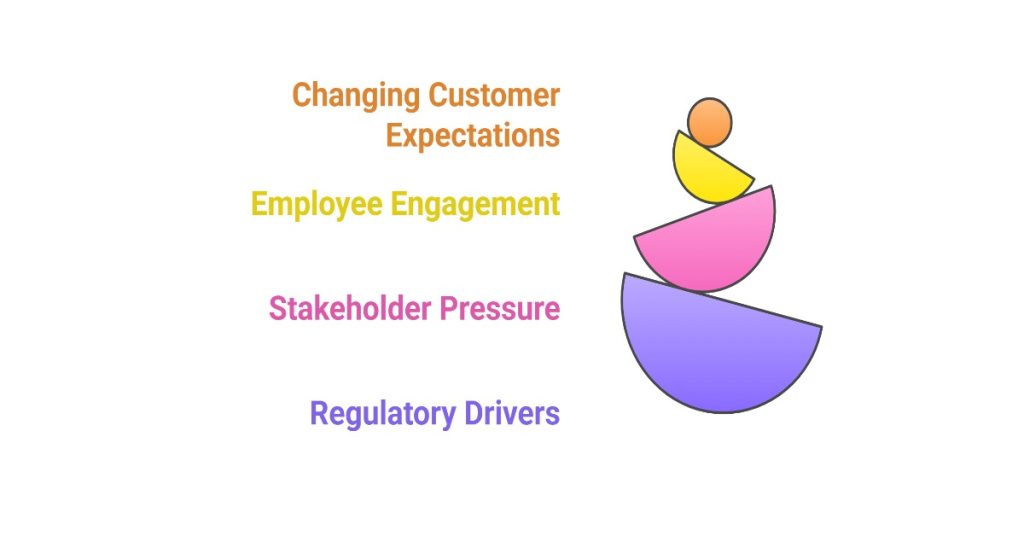
Businesses are standing at a crossroads. In 2025, economic uncertainty, shifting regulations, climate challenges, and social movements are reshaping what it means to be a responsible company. If you feel overwhelmed by these changes or worry about staying relevant and trusted, this blog will help you make sense of why a Corporate Social Responsibility (CSR) strategy is absolutely essential for every company this year.
Let’s break down what, why and how of a CSR strategy so you can move forward with clarity and confidence.
What is a CSR Strategy?
A CSR strategy is a company’s action plan for contributing positively to society, the environment, and the communities it serves, while also fulfilling its long-term business goals. This can involve everything from environmental efforts and ethical labor practices to supporting local charities or building sustainable supply chains.
More than just a “nice to have,” CSR in 2025 is a key part of a brand’s identity and daily operations—not a box to tick for compliance. Companies are increasingly expected to act as global citizens who care about people and the planet, not just profit.
Why CSR Now? 2025’s New Reality
1. Changing Customer Expectations
Today’s buyers are informed and values driven. They want to know how their spending impacts society. A good CSR program isn’t just about attracting customers; it’s about earning their trust, loyalty, and advocacy. In fact, many studies show customers stick with brands whose values they share— even if alternative products may be cheaper.
2. Employee Engagement and Retention
Employees are no longer satisfied by pay alone. They want their daily work to have meaning and align with their own sense of purpose. CSR initiatives have a proven link to higher employee engagement, better retention, and a stronger company culture. Research highlights that purpose-driven workplaces see 95% higher employee loyalty.
3. Investor and Stakeholder Pressure
More investors now screen companies for their Environmental, Social, and Governance (ESG) efforts before committing funds. In 2025, strong CSR strategy can directly influence access to capital and investment opportunities—plus show stakeholders that your business is future-focused and aware of social risk.
4. Regulatory and Market Drivers
From India to Europe to the United States, governments are adopting stricter rules around emissions, labor rights, and corporate governance. Failure to plan for compliance now may mean expensive corrections or public scandals later.

Breaking Down the Benefits of a Strong CSR Strategy
Here’s how a well-built CSR strategy rewards your company:
| Benefit | Impact for Your Company |
| Brand Reputation | Builds trust and recognition |
| Customer Loyalty | Keeps buyers coming back |
| Top Talent Attraction | Draws and keeps the best employees |
| Operational Cost Savings | Streamlines resource use, cuts waste |
| Community Relationships | Supports local development, wins goodwill |
| Investment Opportunities | Increases appeal to ESG-focused investors |
| Competitive Advantage | Differentiates your brand in crowded markets |
| Regulatory Compliance | Future-proofs your business |
Each of these benefits can mean the difference between thriving—and merely surviving—in today’s landscape.
The Biggest CSR Trends Shaping 2025
- Climate Action: Companies are cutting emissions, moving to renewables, and pushing for net-zero goals. Consumers want to see real progress, not just promises.
- Diversity, Equity, and Inclusion (DEI): Workforce diversity, pay equity, and inclusive cultures are now vital parts of CSR, not just HR checklists.
- Transparent Reporting: Stakeholders demand honest, detailed disclosure about social and environmental impact—not generic PR statements.
- Employee-Led Initiatives: Staff want to shape social projects, volunteer, and see the difference their efforts make.
- Responsible Supply Chains: Companies are expected to manage the full social and environmental impact across partners and suppliers, not just in their own office or factory.

Addressing Common Pain Points (and Simple Fixes)
1. CSR Feels Costly or Overwhelming
- Start small. Pick one issue that aligns with your brand values (like plastic reduction or job training). Build up as you learn.
- Get employee feedback on what social causes matter most to them—this fuels engagement and shapes better programs.
2. Concerns About Greenwashing
- Be transparent. Show data, stories, and clear progress. Avoid misleading marketing—let real results do the talking.
3. Difficulty Measuring Impact
- Set clear, measurable goals. Track both short-term outputs (like volunteer hours) and long-term outcomes (such as emissions reductions or scholarships awarded).
- Share results regularly with employees, customers, and partners.
Steps to Build a Winning CSR Strategy in 2025
1. Align with Your Values
Review your mission and core values; select causes that fit naturally with what your company stands for. Authenticity matters—the more aligned your CSR strategy is with your brand, the more genuine and credible it feels.
2. Engage Stakeholders Early
Involve employees, customers, and key partners as you design your CSR strategy. Their input reveals what matters most and creates valuable buy-in.
3. Set Smart Goals
Make your targets specific, measurable, and public—whether it’s reducing emissions, funding education, or supporting local communities.
4. Monitor and Share Progress
Track and publish your results openly. Celebrate wins and acknowledge challenges. This builds trust and keeps everyone active in your journey.
5. Refresh and Reinvent
CSR isn’t a set-and-forget effort. Review your impact each year and stay alert to emerging issues, from new laws to changing social attitudes.

Great Examples from Leading Companies
- LEGO: Focuses on sustainable materials, recycling, and eco-friendly packaging.
- Google: Prioritizes digital equity and green energy.
- Johnson & Johnson: Runs global skill-sharing and healthcare access projects.
These brands show that CSR can fit almost any business model, as long as the efforts are real—and speak to stakeholder values.
The Risk of Ignoring CSR
In 2025, skipping a CSR strategy isn’t an option. Companies without a clear plan face greater risks:
- Falling behind competitors in brand trust and relevance.
- Losing out on top job candidates.
- Suffering public backlash in the event of a crisis.
- Facing legal penalties as global standards evolve.
- Missing new market opportunities that come from sustainability or social innovation.
Read More
How to Make NGO More Appealing to CSR-Focused Companies?
5-Step Guide to Winning CSR Sponsorships for Your NGO: A Comprehensive Roadmap
The Most Profitable CSR Trends for NGOs in 2025
Conclusion: Your CSR Strategy Matters More Than Ever
CSR has moved from the sidelines to the center of smart business strategy. Building a thoughtful, transparent CSR program helps you meet today’s biggest business challenges—while doing really good for people and the planet.
You don’t need to have all the answers immediately. What matters is starting, staying genuine, and sharing your progress. The rewards are clear: better customer relationships, a stronger team, and a business prepared for whatever the future brings.
